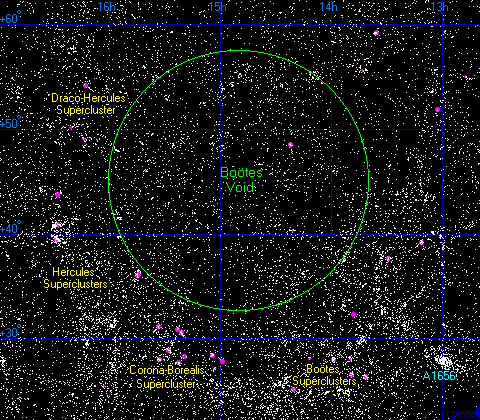
Boötes void
Encyclopedia

Void (astronomy)
In astronomy, voids are the empty spaces between filaments, the largest-scale structures in the Universe, that contain very few, or no, galaxies. They were first discovered in 1978 during a pioneering study by Stephen Gregory and Laird A. Thompson at the Kitt Peak National Observatory...
is a huge and approximately spherically shaped region of space
Interstellar medium
In astronomy, the interstellar medium is the matter that exists in the space between the star systems in a galaxy. This matter includes gas in ionic, atomic, and molecular form, dust, and cosmic rays. It fills interstellar space and blends smoothly into the surrounding intergalactic space...
, containing very few galaxies
Galaxy
A galaxy is a massive, gravitationally bound system that consists of stars and stellar remnants, an interstellar medium of gas and dust, and an important but poorly understood component tentatively dubbed dark matter. The word galaxy is derived from the Greek galaxias , literally "milky", a...
. It is located in the vicinity of the constellation Boötes
Boötes
Boötes is a constellation in the northern sky, located between 0° and +60° declination, and 13 and 16 hours of right ascension on the celestial sphere. The name comes from the Greek Βοώτης, Boōtēs, meaning herdsman or plowman...
, hence its name. Its center is located at approximately right ascension
Right ascension
Right ascension is the astronomical term for one of the two coordinates of a point on the celestial sphere when using the equatorial coordinate system. The other coordinate is the declination.-Explanation:...
and declination
Declination
In astronomy, declination is one of the two coordinates of the equatorial coordinate system, the other being either right ascension or hour angle. Declination in astronomy is comparable to geographic latitude, but projected onto the celestial sphere. Declination is measured in degrees north and...
Description
At nearly 250 million light-years in diameter (approximately 2% the diameter of the visible universe), or nearly 236,000 Mpc3 in volume, the Boötes void is one of the largest known voidsVoid (astronomy)
In astronomy, voids are the empty spaces between filaments, the largest-scale structures in the Universe, that contain very few, or no, galaxies. They were first discovered in 1978 during a pioneering study by Stephen Gregory and Laird A. Thompson at the Kitt Peak National Observatory...
in the universe
Universe
The Universe is commonly defined as the totality of everything that exists, including all matter and energy, the planets, stars, galaxies, and the contents of intergalactic space. Definitions and usage vary and similar terms include the cosmos, the world and nature...
, and is referred to as a supervoid. Its discovery was reported in Robert Kirshner
Robert Kirshner
Robert Kirshner is the Clowes Professor of Science in the Harvard-Smithsonian Center for Astrophysics at Harvard University. Kirshner has worked in several areas of astronomy including the physics of supernovae, supernova remnants, the Large-scale structure of the cosmos, and the use of Supernovae...
et al. (1981), as part of a survey of galactic redshift
Redshift
In physics , redshift happens when light seen coming from an object is proportionally increased in wavelength, or shifted to the red end of the spectrum...
s. The center of the Boötes void is approximately 700 million light years from Earth .
Other astronomers soon discovered that the void contained a few galaxies. In 1987, J. Moody, Robert Kirshner, G. MacAlpine, and S. Gregory published their findings of eight galaxies in the void. M. Strauss and John Huchra
John Huchra
John Peter Huchra [pronounced HUCK-rah] was an American astronomer and professor. He was the Vice Provost for Research Policy at Harvard University and a Professor of Astronomy at the Harvard-Smithsonian Center for Astrophysics. He was also a former chair of the United States National Committee...
announced the discovery of a further three galaxies in 1988, and Greg Aldering, G. Bothun, Robert P. Kirshner, and Ron Marzke announced the discovery of fifteen galaxies in 1989. By 1997, the Boötes void was known to contain 60 galaxies.
According to astronomer Greg Aldering, the scale of the void is such that "If the Milky Way had been in the center of the Boötes void, we wouldn't have known there were other galaxies until the 1960s."
The Hercules Supercluster forms part of the near edge of the void.

